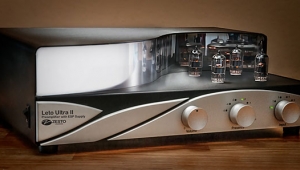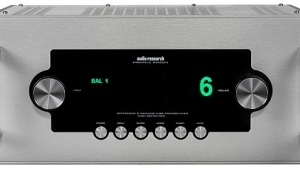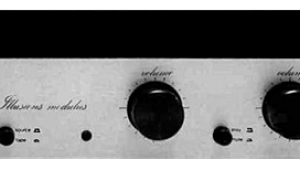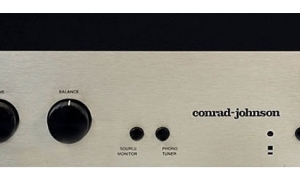| Columns Retired Columns & Blogs |
Audio Research SDP1 multichannel music processor Measurements
Sidebar: Measurements
Footnote 1: Yes, it is possible to use a Home Theater Dolby Pro Logic processor on music signals, but even the best I have heard (the Proceed PAV) introduce some steering artifacts. [The PAV does offer a straight non-processed mode like the ADP-1.]—John Atkinson
The Audio Research's input impedance was very high at around 1M ohms. It will feature very low insertion loss for the unprocessed Left and Right signals. The source impedance of all the SDP1's derived, unbalanced outputs was low, at around 28 ohms.
The SDP1 has controls to optimize the levels of the Surround and Center channels with respect to the main Left and Right signals. The tracking of the three separate level controls for the derived channels was only fair, with a typical error of around 0.2dB. The steps varied between 2 and 3dB at the very top and bottom of the range, reducing to a more useful 1dB in the center. However, as Peter Mitchell has written in these pages, you really need at least 0.5dB-level resolution when optimizing the Surround channels' levels.
With the Center level set to its maximum, the unit's gain was a hair above unity with information in one channel only, rising as expected to 6dB with the same information present in both channels. (The SDP1's Center output is derived by simply adding the Left and Right channels together.) With one channel driven, the maximum gain available to the Surround channels was around 6dB, rising to just over 12dB when the information in one channel was the same as the other but opposite in polarity. (As the SDP1 derives its surround information by subtracting the Left channel from the Right, this situation gives the maximum Surround output.)
To my surprise, the frequency response of the SDP1's derived channels—Center and Surrounds—was not flat. As can be seen in fig.1, the Center channel is shelved down by 2dB above 1kHz, which will tend to prevent high-frequency images from "clumping" in the center. The Surround channels have a response that droops at both frequency extremes—-3dB at 13Hz and 18kHz—as well as cutting off sharply above 20kHz due to the use of a digital delay line.

Fig.1 Audio Research SDP1, frequency response at 1V into 100k ohms set for unity gain (Center top below 1kHz, right channel dashed, 0.5dB/vertical div.).
Leakage from either Center to Surrounds or Surrounds to Center was around -60dB or below over most of the audioband (fig.2), but rose slightly at higher frequencies from the Surround channels to the Center, reaching a maximum of -47dB at 20kHz. This is probably inconsequential, however.

Fig.2 Audio Research SDP1, leakage from Center to Surrounds (top below 1kHz) and from Surrounds to Center (5dB/vertical div.).
A major source of problems with any component that converts analog signals to digital, as the SDP1 does for its surround channels, is input overload: above a certain level, the A/D processor used will hard-clip the signal, producing distortion. Fig.3 reveals that the SDP1's ADC clips at an input level of just over 2V RMS (unbalanced). This is a high output level for a preamplifier—meaning that the power amplifier used will also be either clipping, or just about to be. It will be unlikely, therefore, that an SDP1 user will experience any surround-channel overload with the unit placed after the preamplifier in the signal chain. If the unit is directly fed the output of a CD player or D/A processor, however, some models from Theta and Kinergetics will over-drive the SDP1. (Note that this input overload level is independent of the setting of the SDP1's Surround level controls.)

Fig.3 Audio Research SDP1, Surround channel distortion (%) vs input voltage with level control set to -4.7dB (curve is independent of control setting).
Gordon mentioned in his review that he was bothered by a residual whistle "around 11kHz" in the sound of the Audio Research. Fig.4 shows a spectrum of one of the Surround outputs when no signal was playing. There are indeed some tones in the unit's output: the one at 9.9kHz—pretty close to JGH's estimate—was present under all circumstances; the frequency of the lower component, around 5.6kHz in this graph, was correlated with the time delay chosen (the longer the time delay, the lower the tone's frequency).

Fig.4 Audio Research SDP1, spectrum of Surround channel residual noise, DC-22kHz, ref. 2V output.
What I find fascinating about this graph is that all the spuriae are around 80dB down from a nominal 2V output level. Yet, in JGH's words, "The noise...was faintly audible during quiet program passages when the level was appropriately set." As these whistles were present on the Center output as well as on both Surrounds, I assume that this resulted in "spatial unmasking"—ie, a quiet tone that should have been hidden by the music's spectral content is heard by the listener, because it is perceived as coming from a different direction than the music. Audio Research needs to work a little more to suppress these spuriae, I think. (Incidentally, the unit had been turned on for two hours when I made these measurements.)
Regarding distortion, plotting the THD+noise percentage for the derived channels (fig.5) was misleading, as the actual distortion level was completely swamped by the spurious noises. Looking at the spectrum of a low-frequency tone (fig.6), we can see that the only significant harmonic present is the second at 100Hz, and that, even into the demanding 600 ohm load, it is more than 80dB down (0.01%). The Surround and Center channels were similar in this respect.
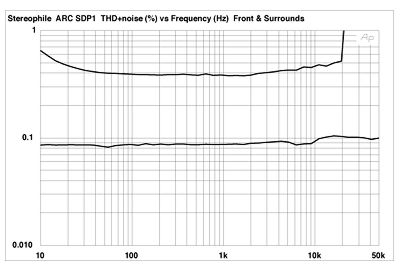
Fig.5 Audio Research SDP1, THD+noise (%) vs frequency at 1V output level (from top to bottom): Surround channel, Center channel.

Fig.6 Audio Research SDP1, Surround channel, spectrum of 50Hz sinewave, DC-1kHz, at 1V into 600 ohms with level control set to its maximum (linear frequency scale).
Though I would like to see (and not hear) lower noise and spuriae levels, the Audio Research SDP1 is one of only two products so far available (the other is the all-digital Meridian 565, reviewed by JGH in June '95) that offers music-lovers who want to get into surround-sound the means to do so without degrading a system's fundamental sound quality (footnote 1). As such, it can be highly recommended.—John Atkinson
Footnote 1: Yes, it is possible to use a Home Theater Dolby Pro Logic processor on music signals, but even the best I have heard (the Proceed PAV) introduce some steering artifacts. [The PAV does offer a straight non-processed mode like the ADP-1.]—John Atkinson
- Log in or register to post comments







